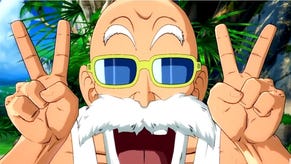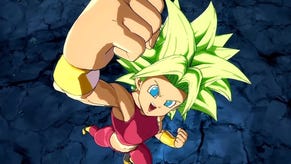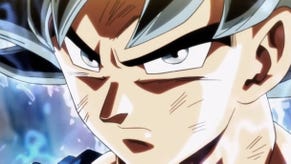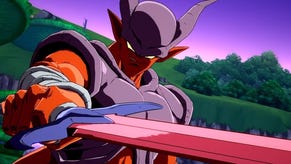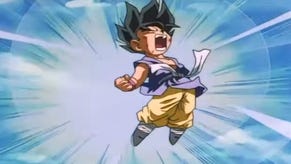Dragon Ball FighterZ review
It's Krillin time.
Dragon Ball FighterZ is a match made in heaven. It's that rare licensed game that comes from the marriage of a developer and franchise who are perfect for each other. What Rocksteady did for Batman, what Rare did for James Bond and what BioWare did for Star Wars, Japanese studio Arc System Works has done for Dragon Ball. The result is an exciting, exuberant and surprisingly rewarding brawler that's one of the best fighting games I've played, and it's not just for genre enthusiasts either.
The first thing that strikes you is just how gorgeous the game looks. This is a 3D game played from a 2D perspective, but the characters, effects and stages are so wonderfully realised that you'd be forgiven for mistaking the video game for the anime upon which it's based. That doesn't even go far enough: Dragon Ball FighterZ at times looks better than the anime.
Arc System Works, which is famous within the fighting game community for the hardcore Guilty Gear and BlazBlue franchises, has done fantastic work making each character in the game look, move, sound and feel like their anime counterparts. Dragon Ball fights are famously over-the-top, and thus, so is Dragon Ball FighterZ. Projectiles such as the Kamehameha Wave fill the screen with energy blasts. If they connect, they trigger explosions that send unfortunate victims flying. Super attacks are inventive, sparkling high damage combos that go off like mini nukes. Dragon Ball FighterZ is one of the most energetic fighting games I've ever played - and that energy is infectious. You sometimes wonder whether the pixels are about to burst with excitement.
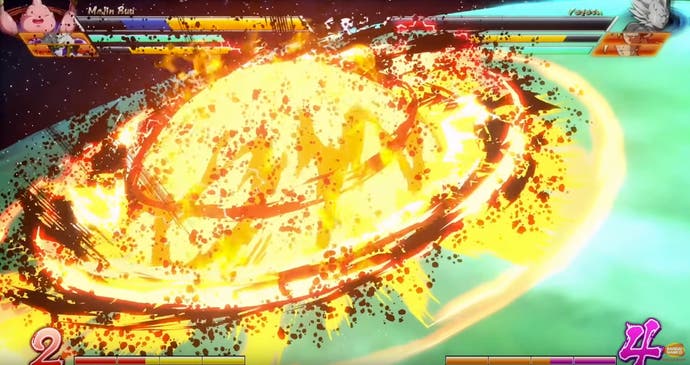
It would probably have been enough for Dragon Ball FighterZ to be a one character versus one character fighting game, but Arc System Works has gone with a three versus three tag battle system that sees each player create a team of characters they can swap between during a match. This benefits the flow of the game in a number of ways. For a start, matches usually last at least a couple of minutes because you've got to knock out three characters instead of one, which lets you really dig into the synergy potential of assists and supers. The game has been tuned to feel high damage - as it should, this being Dragon Ball - but characters have enough hit points to survive a few decent combos. The upshot is a "not too fast, not too long" feel to fights, which I love. But most important of all, it's just bloody exciting to see loads of Dragon Ball characters smashing each other up all at once.
By going with a three versus three system, Arc System Works has given itself the opportunity to add transitional flourishes that reinforce the sense you're playing the anime. When a character is downed, rather than keep the victorious character where he or she is and bring in another character, Dragon Ball FighterZ triggers a short cutscene that sees the next fighter fly into the scene and lock horns with the active character. This is a super cool visual transition that's about as Dragon Ball as you can get, and despite you seeing it multiple times per match, it never gets old.
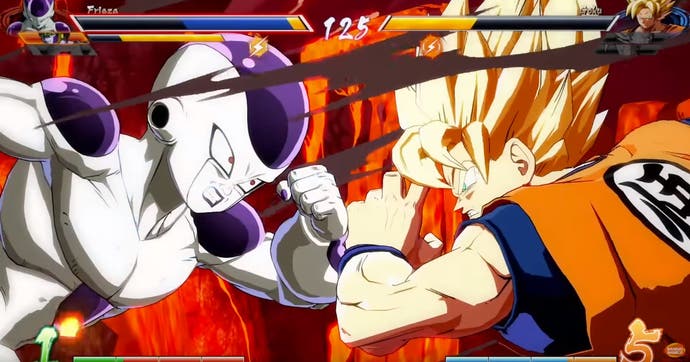
There's an additional layer to this transition that shows Arc System Works is in top form. After the transition is complete, the fighters reset to neutral, which means they begin the fight in the standard positions in the stage. This is a subtle but brilliant mechanic that gives players a chance to breathe, and prevents the annoying corner pressure following a down you can get from other tag-based fighting games. Arc System Works really does know what it's doing.
If you down a character with a heavy attack, you'll send them flying off into a mountain or a ruined skyscraper for a classic anime smash. If you end a match with a super, you might trigger a super cool cutscene where the camera pulls back to show the energy blast in all its glory (I'm not sure how there's any planet left for these people to fight on, given how out of control these energy blasts get). There are even nostalgia-fuelled cinematic Easter egg "dramatic" finishers, which I won't spoil here, that come about when certain characters defeat certain other characters. And the pre-fight trash talk! Like in the anime, the characters in Dragon Ball FighterZ like to tell their opponents they're going to beat them up. A lot. Top bants.

Clearly, Arc System Works has nailed the Dragon Ball franchise. Everything about the game screams, "we love this crazy anime just as much as you do!". But none of that would matter if the actual fighting wasn't up to much. Thankfully, but perhaps unsurprisingly given the developer's pedigree, Dragon Ball FighterZ is as much fun to play as it is to watch - for fighting game newcomers and veterans alike.
Dragon Ball FighterZ is an accessible fighting game pretty much anyone can pick up and play, but there's enough to it to keep fighting game aficionados hooked. Special move and super input commands are simple and universal across all the 24 characters, so you rarely have to look at the special move list. Auto combos mean you can mash a single button and get a decent amount out of it. Throws are a one-button affair that sees your character fly a short distance to attempt a grab that leads directly into an air combo. You can reflect attacks with the push of a direction and a button. There's even a flying homing attack, triggered with the press of a button, that, if it lands, lets you start a combo.
Accessibility is a dirty word within the fighting game community, but with Dragon Ball FighterZ it's a boon. Players who take the time to learn the game's system will unearth counters for pretty much all the casual-focused mechanics in the game. Auto combos will not do as much damage or build as much super meter as manual combos concocted in the lab. Throws can be batted away with good enough timing. The flying homing attack can be effectively countered with a well-timed heavy attack. Players who spam projectiles can be defeated with well-timed flying homing attacks. You see where this is going.

There are loads of fighting games that have auto combos and accessible mechanics, but the great - and I would say surprising - thing about Dragon Ball FighterZ is that the more you dig into it, the more its depth reveals itself. At a certain level of play you need to employ mixups, apply pressure with assists, zone and execute lengthy, high damage combos to win. There are instant air dashes, super jumps and combo extending vanish attacks to get to grips with. Sure, Dragon Ball FighterZ is pretty forgiving when it comes to input timing, but there's plenty of room for enthusiasts to express themselves.
Indeed, Dragon Ball FighterZ' skill ceiling is surprisingly high for a game with such a low level of entry. It's early days, of course, and good fighting games continue to reveal their secrets months and even years after release, but players who got stuck into the pre-release betas are already having fun with delayed super combos (cancelling one character's super move animation into a second character's super), which appear to ignore the standard assist lockout. Already you can tell Dragon Ball FighterZ is a game with exciting combo potential. This is a fighting game that lets you stock a whopping seven levels of meter. When you consider the super duper combos burn a maximum of three levels of meter, there's a lot of room for eye-popping, three-digit combos with pretty much every character. I mean, just look at this:
And this:
And this!
Speaking of characters, I was initially concerned that the launch roster of playable fighters worked too similarly. As a Dragon Ball noob, I thought a lot of the characters looked the same and, because of the universal input commands, fought the same. I found - and still do - it hard to tell much of a difference between Goku, Vegeta, Gohan and the other saiyans. Variations on characters - Gohan Kid / Gohan Adult, Goku / Goku Black - felt like filler. But as I experimented with the characters, I found enough variation in styles to keep me interested.
The best characters - well, the most interesting, at least - are for me the non-saiyans. Captain Ginyu is a great example. This muscle-bound beast has a special move that calls in a member of the Ginyu Force for an assist, and a super that lets you control your opponent's character, leaving your opponent controlling Ginyu. No-one else in the game can do that! The teleporting Hit can counter supers. Nappa can plant little Saibamen, which grow over time and attack his opponent. And Majin Buu... well... just look at him (it?).
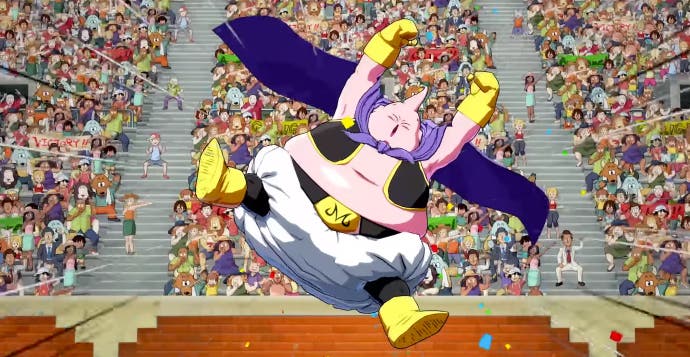
Amid the breathless brilliance, Dragon Ball FighterZ does flounder in parts. The story mode is an initially impressive take on the much-maligned fighting game campaign that sees you move about a map via a grid system, but after you've defeated your thousandth clone and realised there's little to no strategy or interesting decisions to make outside the fighting, it starts to grate.
The story revolves around goodies and baddies coming together to defeat the ravenous Android 21, a being who turns her enemies into sweets before gobbling them up. Dragon Ball fans will no doubt get a kick out of the cutscenes, some of which you only trigger when you've got certain characters in your team, but I found most pretty boring (I only soldiered through the story to unlock Android 21 as a playable character). When Dragon Ball characters aren't screaming because they're powering up an energy blast or taking one to the face, they are standing very still while barking mind-numbing exposition.
Elsewhere, the arcade mode is interesting in that your path through it depends on the rank you get in each match, but my main motivation to play was to unlock different versions of the characters. There's an offline and online lobby that lets you control a chibi version of one of the characters and walk around a plaza, but once you get past the novelty of the thing, you find yourself instantly bringing up the traditional menu to teleport to the NPC you have to interact with to play the mode you want.
And a word on the in-game shop. There are two virtual currencies: Zeni and Premium Z Coins. Zeni is used to buy loot boxes that contain cosmetic items only. At the time of launch you can't buy Premium Z Coins with real world money. Rather, you get a Z Coin when you pull a duplicated item from a loot box (10 Z Coins can then be traded for a unique item). So it all feels relatively inoffensive. I ignored the shop and, through the course of playing the tutorial, combo challenges, story mode, arcade mode and other parts of the game, had more than enough Zeni to keep me going. But, you know, loot boxes. In a fighting game. Why?
In truth, none of Dragon Ball FighterZ' mild missteps sully the brilliance of the overall experience (the worst thing about the game, in truth, is the highly offensive use of the letter z instead of an s in its title). This is a game that grabs you by the scruff of your neck and, like Goku transforming into a Super Saiyan, blasts you in the face with an infectious energy you can't help but embrace. It is a game delicately crafted to appeal to newcomers, perhaps those who love Dragon Ball but have never played a fighting game before, as well as the fighting game community. On the latter group, Dragon Ball FighterZ feels like just the tonic after the bitterly disappointing Marvel vs. Capcom Infinite. Where Capcom's effort was low grade, Arc System Works' is top notch. Where Marvel vs. Capcom Infinite feels like playing a Marvel game built through gritted teeth, Dragon Ball FighterZ feels like playing a Dragon Ball game built by the anime's biggest fan. For me, Dragon Ball FighterZ is the best tag-based fighting game since Marvel vs. Capcom 2. I can't think of higher praise.







